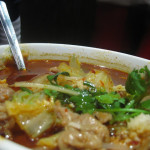Time was that the British working man came home from work and expected the dinner on his table to be good old-fashioned no nonsense British fare – meat and two veg, with fish and chips on Friday. None of your foreign muck. What boring diets we had in those days, you might think – though in practice there were many ways with eating forgotten along the way.
Then something changed in our culture: we discovered the joy of eating styles of food imported from elsewhere. Granted that in the early days, Indian was a fairly basic style of curry (I remember my first restaurant curry – a fairly grey and bland sauce which contained carrots! The restaurant was in Chester), and Chinese cooking was of a quality you would never find in China, but we Brits gradually became far more cosmopolitan and sophisticated in our eating styles.
Inevitably that trend was partly fuelled by the arrival of immigrant communities from the Caribbean, the Indian subcontinent, Uganda and other places, many of whom began to open their own shops and to import products needed to make the dishes they used to cook in the old country, and then to open restaurants. It did not take the native Brits long to catch on.
On the restaurant scene came an explosion of diverse eating options from around the globe. More than that, our cooking habits changed permanently. Within my lifetime I remember when pasta meant canned spaghetti, and when in the early 70s my mother began cooking the now ubiquitous spag bol it was a novelty – even more so when my friends came to eat with us and struggled to master the technique to wind spaghetti around their forks and shovel it in their mouths. They probably do it every day now.
Gradually, helped by TV cookery programmes, our repertoires widened, we learned how to stir fry and mix spices. Eventually we realised that you steamed rice delicately, rather than boiling into a mush. We discovered the difference between korma and vindaloo, used naan breads, bought into the flourishing market for ethnically diverse foods as the supermarkets began to tap into a huge new market. Voila! Suddenly the national dish is Chicken Tikka Massala, possibly invented in Glasgow, though there are many in Birmingham and Bradford that would dispute that version of realty!
Not only that but we travelled far and wide, finding dishes that were not previously available to us. And in due course the food industry caught up with us, offering ingredients approximating to those we had sampled on holiday. Of course, there is no putting the genie back into the bottle. Once we have scoured Asia, the Americas and beyond, our curiosity is never sated, so the search is on for the next flavour of foods to be branded and exploited.
One example is Ethiopian. During the course of the summer holiday with my kids, we were in Seattle and fancied trying something different (in fact we ate a different style pretty much every day – you name it, we tried it!), so we went to a small suburban Ethiopian restaurant in Seattle, not far from our B&B. Arguably the dishes were not that different to other African curries and stews, but serving them on a large, flat, spongy injera bread, with more injera to scoop up the sauces. A novelty for the kids, though in that respect, it’s very like the traditional Indian way of using chapati to eat curries.
But then again one thing that unites all people of any race, colour and creed is that we all need to eat and drink. There might be a million local variations of everything, but many of the dishes we consume everywhere are similar: the Italians gave us pasta, but the Chinese and other Asian cultures gave us noodles – though they might equally have sprung up spontaneously anywhere else in the world. You might associate the curry with India, but most nations have developed their own tradition of indigenous spicy dishes, using chillis and other spices that began to travel the globe with the early merchants. Just as Mexico has its mole poblano, South Africa has bobotie, and Indonesia its satay, spiced foods are found everywhere (a quick survey of national dishes demonstrates the point!)
On one hand food evolves as it traverses the globe, but on the other there is a very real desire for restauranteurs to advertise food served as being “authentic” to one area. You might conceivably make food typical of the area, but what is authentic anyway? If you travelled along Curry Mile in Rusholme, Manchester and asked each restaurant for its secret recipe for lamb bhuna, for example, you would probably get as many variations as you had restaurants, and even then you might argue that the degree of authenticity to bhuna gosht made in homes in Hyderabad is at best questionable, and then to how it was made for the Mughal emperors of yore is even more doubtful.
Bottom line is that food travels and food changes – unless it is from a burger chain. Long may it continue to do so!







